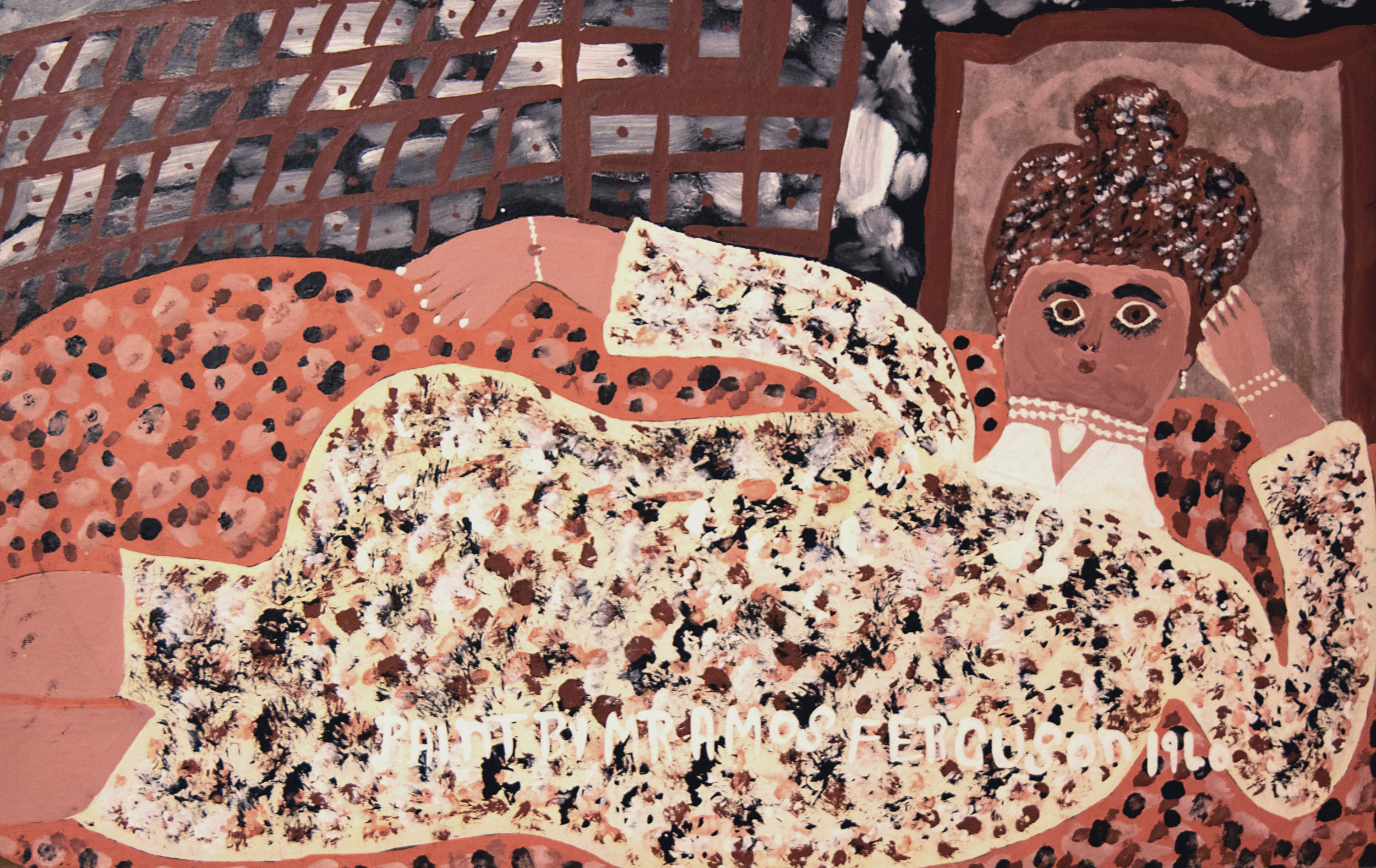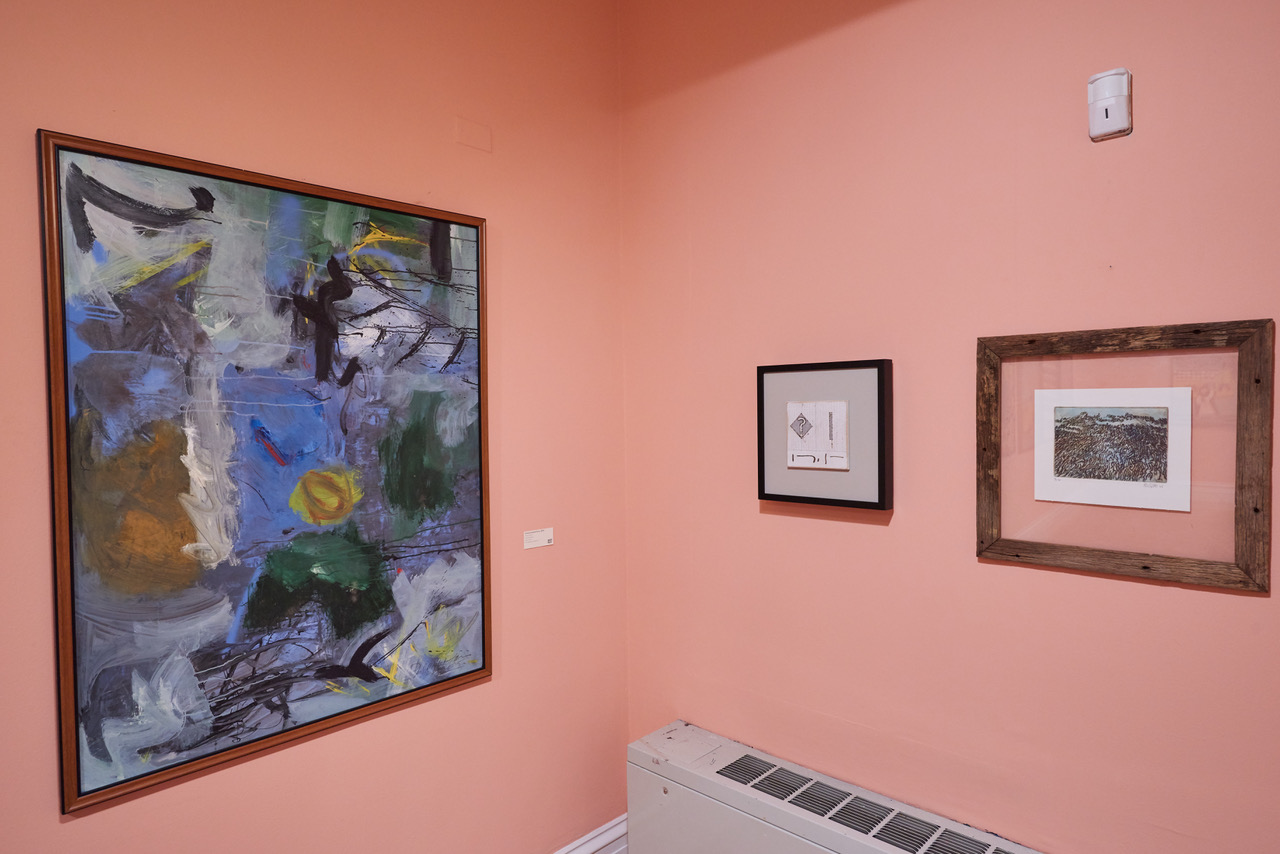Sitting Pretty Political: Amos Ferguson and the Reclining Women of Art History
Natalie Willis · 8

One of the key poses for women in classical painting is the reclining nude. It’s become such a huge part of the canon of European historical paintings, no doubt in part to the patriarchal obsession with the naked female form. Nonetheless, it’s been rich territory for many an earth-shattering painting in art history: Titian’s Venus of Urbino (1532-34), Jean Auguste Dominique Ingres’ Grande Odalisque (1814), and Manet’s infamous Olympia (1865), all of which changed the art world’s reading of the pose each time. It should come to us as no surprise then that Amos Ferguson, our beloved (and often misunderstood) intuitive painter from Exuma, might want to make his own mark in such territory, though perhaps more conservatively given his very religious background.
Amos Ferguson’s Reclining Woman On Sofa (1960), is a very early work for Ferguson, perhaps marking his own dabblings and understandings in the wider art historical canon – or at the very least, how incredibly accessible this particular image has now become something of a “default” for us. From paintings to marble sculptures, the image of the “ideal” feminine (often European, often slim) is ubiquitous, and this spills out into the mainstream, and contrary to popular belief, the “art world” is not separate from our everyday reality and the “wider world”. This is why Ferguson’s portrayal becomes so interesting for our space, standing in stark contrast to Brent Malone’s sensuous nudes and to the painting lineage they are descended from, not just because Ferguson is an intuitive artist and not formally trained, but because his focus and perspective are so vastly different.

It’s also an older work in Ferguson’s practice, dating to 1960, and as such the playfulness with paint is quite different – patterned backdrops, patterned sofa, even a patterned dress and hair in loose brush strokes rather than the usual perfectly formed circles made from the flat head of a nail. The interest the piece captivates and holds in us, despite being so small, was clearly not missed on the collectors either. The piece was purchased by the late Vincent D’Aguilar himself and was shown at one of the early shows in the NAGB’s history.
One Man’s Vision in 2003, the year the NAGB opened, formed a large part of the museum’s opening and gave us our first critical look into the significance of the collection. D’Aguilar, as part of the exhibition, gave a personalised walkthrough of the works and the history of these cultural treasures he had been collecting since the ’70s. He had purchased the work from a widower whose wife had owned the work though he hadn’t shared his wife’s interest in art. Woman Reclining on a Sofa, also known as Woman Lying on a Couch (1960), was unsigned when D’Aguilar purchased it, and being the industrious man he was, he took it to Ferguson to confirm who signed and dated it on their meeting. For D’Aguilar, it was the only painting he had seen like this by Ferguson – and I’d have to agree – and as the painting was unsigned for so long, he felt that it must have not been made for tourist market. Of course, as with most of Ferguson’s work, when he did sign it, it proclaimed his name big and bold and proud along the bottom of the frame.
Quite a gem in the collection of the D’Aguilar Art Foundation, we see in this deceptively small, powerful work showing a woman decked in the garb of days gone by – a luxuriant gown, a larger than life updo, and pearls. Ferguson highlights that we are also a place that revels in old, usually British or American, ideals of luxury. Ferguson had a sort of access to spaces through his work as a house painter and furniture finisher that most Bahamians would not have been afforded, so the pearls and fine dress seen in his 1960 painting could very well be a nod to the artwork he saw in homes in Lyford Cay, as he has previously stated in interviews. In a similar vein, we have seen in Eric Rose’s black and white photography series of young men from Over-the-Hill dressed in black and white suits lounging in Lyford Cay seem fit for the gentry. The men look more akin to 1893 and the class struggle of that time than the year they were taken. The image, set against the backdrop of Lyford Cay gated estates luxury, might date to 1993, but in some ways we are still dealing with the same class struggles. Though, in Rose’s image the young men might be slightly more comfortable in Nike Jordans than brogues, but the pageantry and performance of status remains – just as Ferguson harkens to another time but the wealth and prim-properness associated with the pearls donning our reclining lady’s neck still hold similar social weight.
It’s worth noting that this reclining lady, though her pose might be suggestive with her hand strewn across the back of the sofa and the other propping her head up with subtle provocation, she is also taking up the majority of the frame. This is a big statement, especially for a woman of her complexion, as Ferguson’s women when, not biblical figures, are often women of color. The size of her within the work is a nod to her importance, as Ferguson regularly paints the women in his work larger than men – if you look closely enough. It makes us wonder what his feminine subjects might have looked like had he been around now. In any case, it’s a treat to have such a physically small work disrupt such a large, lofty history in the gallery.
Ferguson’s work is currently on view as part of the National Art Gallery of The Bahamas’ permanent exhibition, Hard Mouth: From the Tongue of the Ocean, on view through June 2, 2019.


